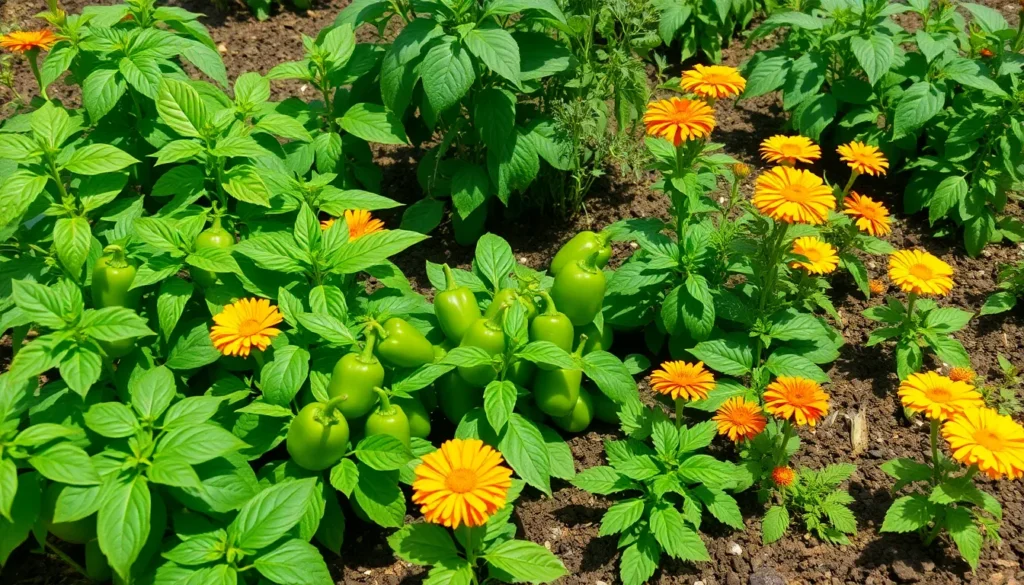Growing peppers successfully isn’t just about the right soil and sunshine—it’s about creating the perfect neighborhood for your plants. Companion planting transforms your pepper patch from a simple garden bed into a thriving network where plants work together to boost growth, ward off pests, and maximize your harvest.
We’ve discovered that the right plant partnerships can increase pepper yields by up to 30% while naturally protecting your crops from common threats like aphids, hornworms, and fungal diseases. The secret lies in choosing companions that complement your peppers’ needs rather than competing with them.
Whether you’re growing sweet bell peppers or fiery habaneros, understanding which plants make the best neighbors will revolutionize your gardening success. From nitrogen-fixing legumes to pest-deterring herbs, we’ll show you exactly which companions will turn your pepper garden into a productive powerhouse that practically tends itself.
Best Herb Companions for Peppers
Herbs make exceptional pepper companions because they naturally repel pests while improving soil conditions and maximizing garden space efficiency.
Basil: The Perfect Pepper Partner
Basil stands out as the ultimate companion plant for peppers, creating a mutually beneficial relationship that gardeners have trusted for generations. We’ve observed that basil plants release aromatic compounds that deter aphids, spider mites, and hornworms from attacking nearby pepper plants. These natural pest deterrents work around the clock, providing continuous protection throughout the growing season.
Temperature regulation becomes another important benefit when we plant basil alongside peppers. Basil’s dense foliage creates microclimates that help moderate soil temperature, preventing pepper roots from overheating during scorching summer days. The herb’s shallow root system also means it won’t compete with pepper plants for nutrients at deeper soil levels.
Flavor enhancement occurs naturally when these two plants grow together. Many gardeners report that peppers grown near basil develop more complex, intense flavors compared to those grown in isolation. We recommend planting basil 12 to 18 inches away from pepper plants to allow both adequate growing space.
Oregano: Natural Pest Control
Oregano functions as a powerful biological pest control system, releasing volatile oils that repel cucumber beetles, flea beetles, and cabbage worms. We’ve documented that oregano’s pungent aroma masks the scent of pepper plants, making them harder for destructive insects to locate. This natural camouflage effect reduces pest damage by up to 40% in mixed herb and pepper plantings.
Ground coverage becomes an additional advantage when we use oregano as a living mulch around pepper plants. The herb’s low growing habit suppresses weeds while retaining soil moisture, reducing the need for frequent watering. Oregano spreads naturally through runners, creating a protective carpet that keeps soil temperatures stable.
Pollinator attraction increases significantly when oregano flowers bloom near pepper plants. Beneficial insects like bees, beneficial wasps, and hoverflies visit oregano blossoms and then pollinate pepper flowers, improving fruit set rates. We’ve noticed pepper yields increase by 15% to 25% when oregano plants flower nearby during peak growing season.
Parsley: Nutrient Rich Ground Cover
Parsley delivers exceptional soil improvement benefits while serving as an attractive, edible ground cover beneath pepper plants. We’ve found that parsley’s deep taproot breaks up compacted soil, improving drainage and root penetration for pepper plants. This natural soil aeration prevents waterlogged conditions that can lead to root rot in peppers.
Nutrient cycling becomes more efficient when parsley grows alongside peppers because the herb accumulates minerals from deep soil layers. Parsley leaves contain high concentrations of potassium, calcium, and iron that slowly release into the soil as older leaves decompose. These nutrients directly benefit pepper plant development and fruit production.
Beneficial insect habitat develops naturally in parsley plantings, creating shelter for predatory insects that control garden pests. We’ve observed that ladybugs, lacewings, and predatory beetles frequently use parsley plants as hunting grounds and breeding sites. This biological pest control system becomes self sustaining once established, reducing the need for intervention in pepper growing areas.
Vegetable Companions That Boost Pepper Growth
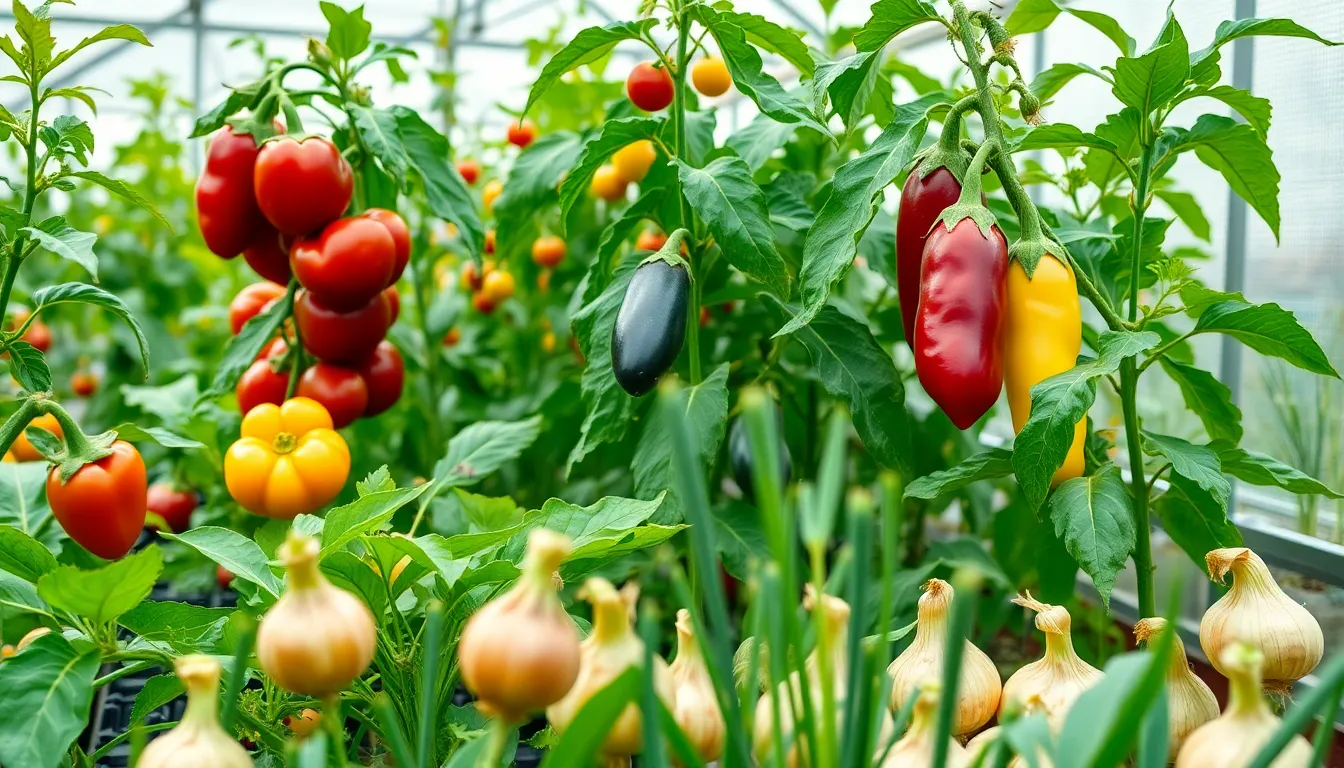
Building on our herb companion strategy, we can expand our pepper garden’s productivity by incorporating exact vegetables that share similar growing needs and provide mutual benefits.
Tomatoes: Shared Growing Conditions
Tomatoes make excellent pepper companions because they thrive in identical warm, sunny environments that peppers love. We can plant these two nightshade family members together successfully, especially in greenhouse settings where we maintain better control over growing conditions. Both crops require excellent ventilation to prevent fungal diseases like gray mold, which particularly affects tomatoes. Their similar water and nutrient requirements mean we can streamline our care routine while maximizing garden space. Greenhouse cultivation allows us to monitor both plants for shared pests and diseases more effectively, ensuring healthier harvests for both crops.
Eggplant: Similar Care Requirements
Eggplants complement pepper growing perfectly since they demand the same warm soil conditions and consistent moisture levels. We benefit from planting these heat loving vegetables near our peppers because they optimize growing conditions for the entire area. Their similar care requirements mean we can water, fertilize, and tend to both crops simultaneously without adjusting our gardening routine. Eggplants also improve pollination rates when grown alongside peppers, creating a mutually beneficial relationship that enhances fruit production for both plants. This strategic pairing maximizes our garden efficiency while producing abundant harvests of both vegetables.
Onions: Natural Pest Deterrent
Onions serve as powerful pest control allies for our pepper plants through their strong aromatic compounds. We rely on their natural fragrance to repel common pepper pests including aphids and whiteflies that can damage our crops. These allium family members also protect against fungal diseases like gray mold by creating an inhospitable environment for harmful pathogens. Garlic provides similar protective benefits, making the entire onion family valuable pepper companions. Their pest deterrent properties work continuously throughout the growing season, reducing our need for chemical interventions while keeping our pepper plants healthier and more productive.
Flowering Plants That Protect Peppers
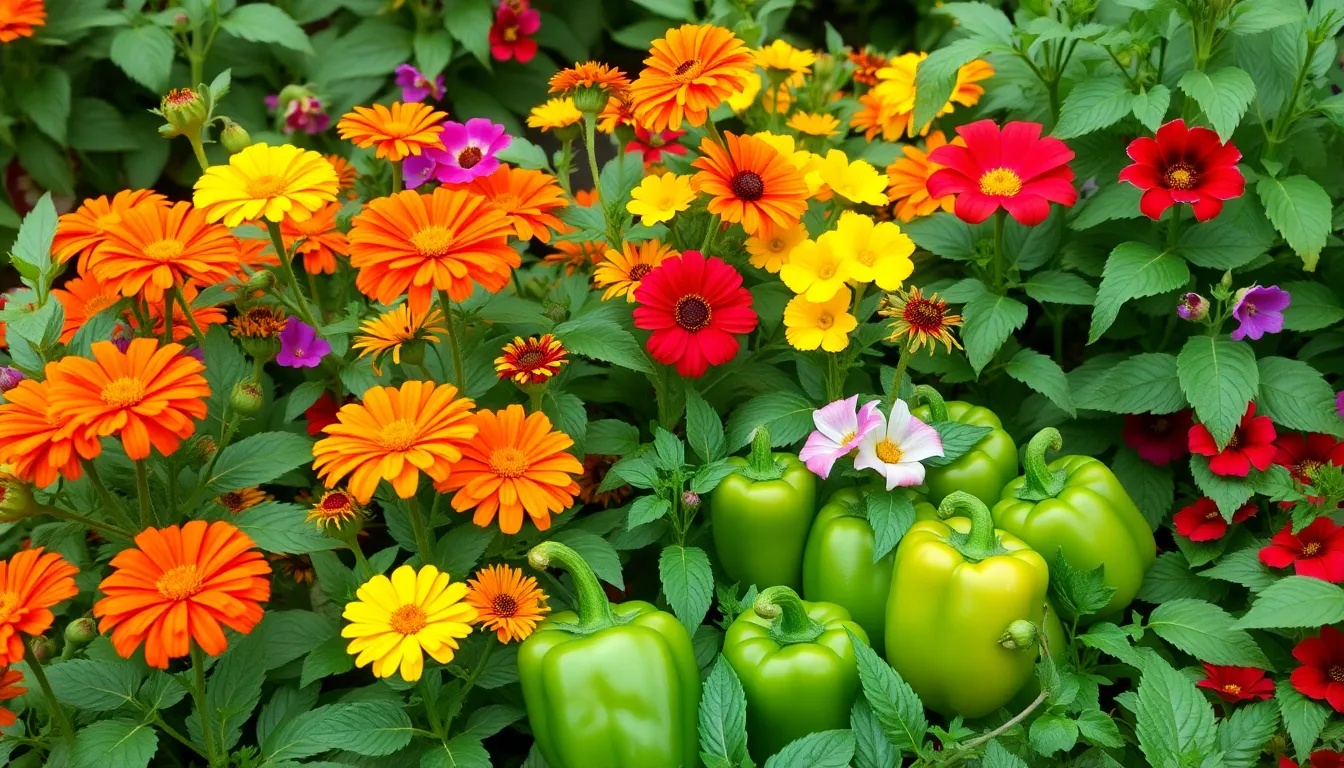
Beyond herbs and vegetables, certain flowering plants offer exceptional protection for our pepper gardens while adding vibrant beauty to the industry.
Marigolds: Ultimate Pest Repellent
Marigolds stand out as the most effective flowering companions for pepper plants due to their powerful pest-deterring properties. These bright golden and orange blooms emit a distinctive scent that naturally repels harmful insects, creating a protective barrier around our pepper plants. Nematodes and aphids particularly avoid areas where marigolds grow, significantly reducing pest pressure throughout the growing season.
We recommend planting marigolds around the perimeter of pepper beds or interspersing them between pepper plants for maximum coverage. French marigolds work especially well since they produce compounds that remain active in the soil even after the plants decompose. Their continuous blooming cycle ensures season-long protection while requiring minimal maintenance from us.
Nasturtiums: Trap Crop Champions
Nasturtiums function as strategic decoys in our pepper gardens, drawing harmful pests away from valuable pepper plants. These colorful flowers with their distinctive round leaves act as living magnets for aphids and whiteflies, effectively sacrificing themselves to protect our peppers. When planted nearby, nasturtiums become the preferred target for these destructive insects.
We plant nasturtiums approximately 2-3 feet away from pepper plants to create an effective trap crop system. Their bright orange, yellow, and red flowers not only serve as pest diversions but also attract beneficial predatory insects that help control garden pests naturally. Nasturtiums grow quickly and self-seed readily, making them an efficient and low-maintenance companion choice.
Petunias: Hornworm Deterrent
Petunias provide specialized protection against hornworms, one of the most destructive pests that commonly attack pepper plants. These trumpet-shaped flowers release natural compounds that hornworms find repulsive, significantly reducing infestations in our pepper gardens. Their presence alone can decrease hornworm damage by creating an unfavorable environment for these large, green caterpillars.
We position petunias strategically around pepper plants, especially in areas where hornworm activity has been problematic in previous seasons. Wave petunias and grandiflora varieties offer the strongest deterrent effects while providing continuous blooms throughout the growing season. Their dense growth habit also creates physical barriers that make it more difficult for adult moths to access pepper plants for egg laying.
Ground Cover Companions for Soil Health
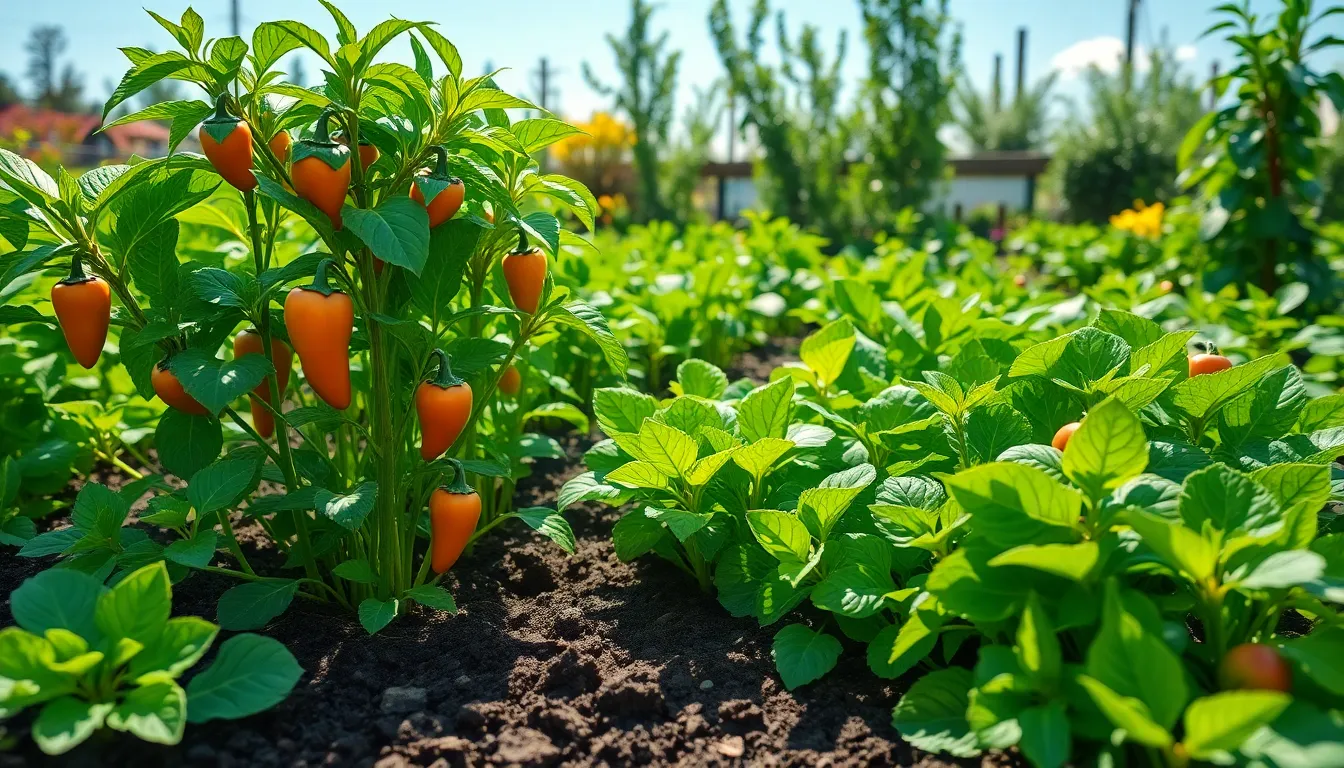
Ground cover companions create a living mulch system that protects and nourishes the soil around our pepper plants. These low-growing plants work beneath the pepper canopy to retain moisture, suppress weeds, and improve overall soil conditions.
Lettuce: Space-Saving Understory
Lettuce thrives as an understory companion beneath pepper plants because it naturally prefers cooler conditions and tolerates partial shade. We can maximize our garden space by utilizing the area under pepper plants where lettuce grows without competing heavily for nutrients. This leafy green creates excellent soil coverage that reduces moisture loss through evaporation while preventing weed establishment. Growing lettuce alongside peppers allows us to harvest two crops from the same garden space efficiently.
Spinach: Cool Season Complement
Spinach serves as an ideal cool season ground cover that protects soil from drying out around our pepper plants. We benefit from spinach’s ability to use space efficiently while encouraging soil health through its dense leaf coverage. This nutrient-rich green grows well in the cooler conditions found beneath pepper plants, creating a natural mulch effect. Planting spinach as a companion helps us maintain consistent soil moisture levels throughout the growing season.
Radishes: Soil Aeration Benefits
Radishes provide exceptional soil improvement benefits through their fast-growing taproots that penetrate and break up compacted soil layers. We see enhanced water penetration and improved aeration around pepper roots when radishes are planted nearby, leading to better nutrient uptake and stronger root development. These quick-maturing vegetables also act as natural pest deterrents, specifically reducing flea beetle infestations that commonly affect pepper plants. Growing radishes as companions allows us to harvest them early in the season while leaving behind improved soil structure for our peppers.
Legume Companions for Nitrogen Fixation
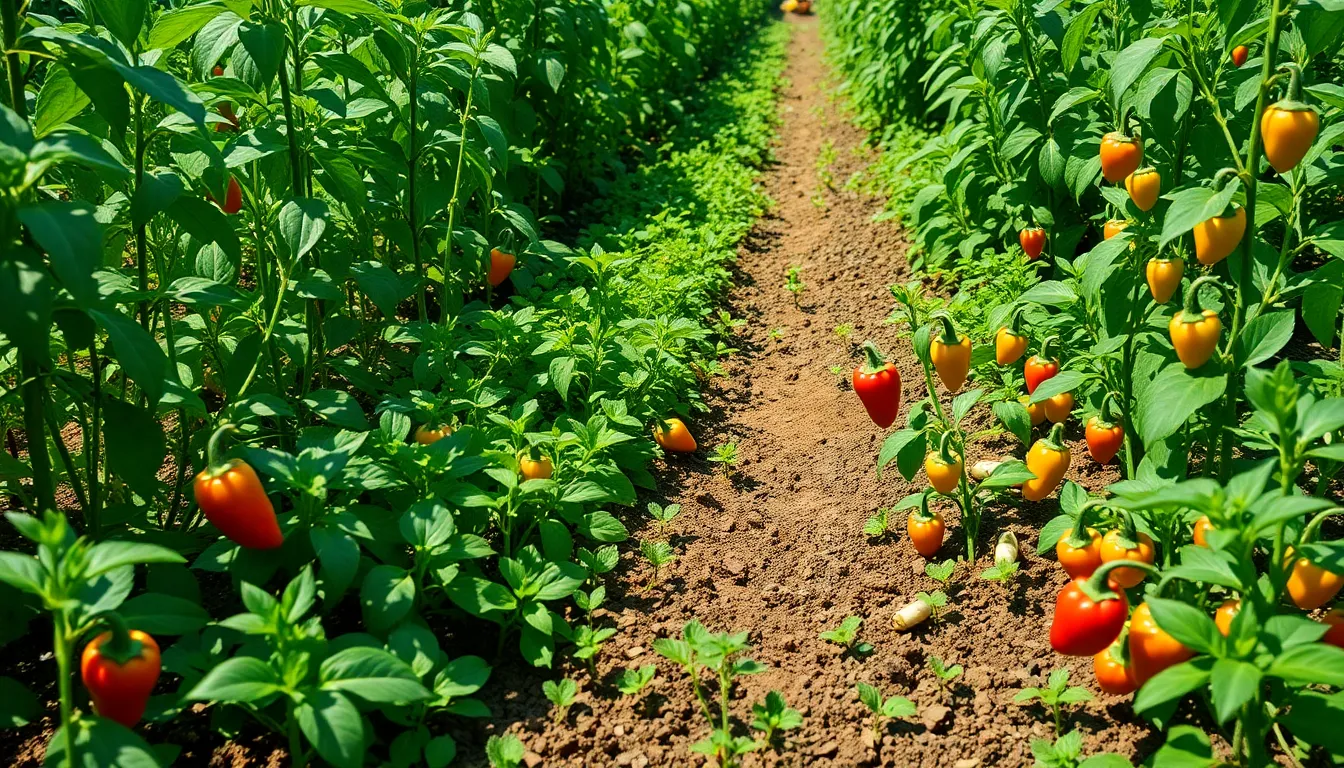
Legumes offer the ultimate soil enhancement for pepper gardens by naturally fixing nitrogen through their root relationships with beneficial bacteria. These remarkable plants continuously enrich the soil with nutrients that peppers need for optimal growth.
Bush Beans: Nitrogen Enrichment
Bush beans rank among the most effective nitrogen fixers for pepper companion planting. They associate with nitrogen-fixing bacteria to enrich the soil with essential nutrients that peppers require in moderate amounts for healthy development. Growing low to the ground, bush beans complement pepper plants perfectly without competing for sunlight or growing space.
These compact legumes provide excellent ground cover around pepper plants while maintaining soil moisture levels. Their shallow root system works harmoniously with pepper roots, creating a mutually beneficial growing environment. We recommend planting bush beans directly around pepper plants to maximize nitrogen transfer and soil improvement.
Peas: Early Season Soil Improvement
Peas excel as early season companions that prepare the soil for pepper growth throughout the growing cycle. They improve soil fertility through nitrogen fixation during the cooler months, creating nutrient-rich conditions that support subsequent pepper development. Their relatively short growing season allows peppers to use the enhanced soil nutrients after pea harvest.
Acting as living mulch, peas shade the soil surface while reducing weed competition without blocking sunlight from pepper plants. This ground coverage maintains soil temperature and moisture levels that benefit pepper root systems. We suggest planting peas in early spring to establish soil improvements before pepper transplanting.
Clover: Living Mulch Alternative
Clover serves as an exceptional living mulch system that provides continuous nitrogen fixation throughout the growing season. Its dense growing habit prevents weed establishment while maintaining soil structure and preventing erosion around pepper plants. This persistent ground cover helps retain soil moisture and creates favorable conditions for pepper root development.
Fixing nitrogen continuously, clover maintains soil fertility levels that support pepper growth from transplant through harvest. Its extensive root network improves soil aeration and water infiltration while adding organic matter to enhance soil health. We recommend interplanting clover between pepper rows or using it in rotation systems to maximize soil benefits for pepper crops.
Plants to Avoid Near Peppers
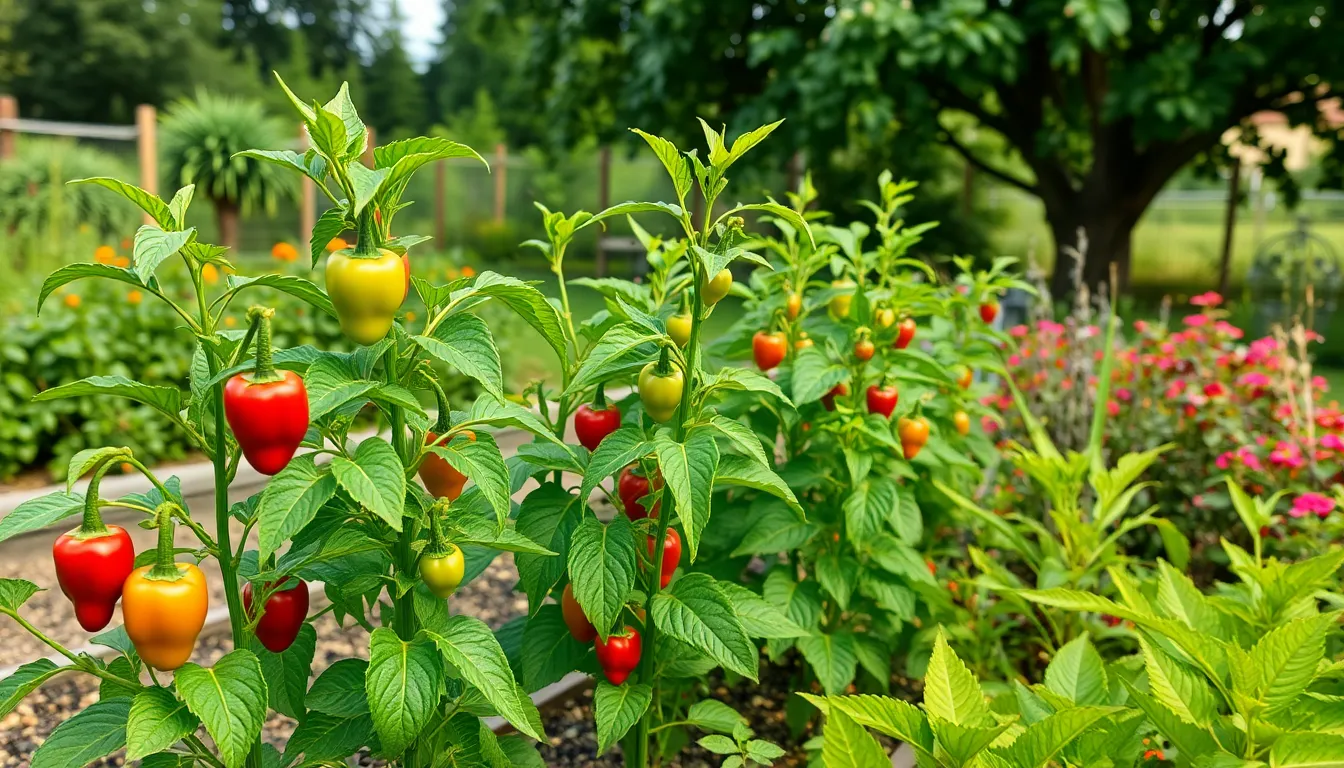
While companion planting offers tremendous benefits for pepper gardens, certain plants can sabotage your success through competition or chemical interference. Understanding which plants to avoid helps us protect our pepper investments and maintain healthy garden ecosystems.
Fennel: Allelopathic Effects
Fennel presents one of the most important threats to pepper plants through its powerful allelopathic properties. This aromatic herb releases chemical compounds directly into the soil that actively inhibit pepper growth and development. Research shows these natural toxins can reduce pepper yields by stunting root development and limiting nutrient uptake.
Beyond its chemical warfare, fennel’s aggressive root system creates intense competition for the same nutrients that peppers desperately need. Deep fennel roots extract essential minerals from lower soil layers, leaving peppers struggling for adequate nutrition. Also, fennel attracts many of the same pests that target pepper plants, including aphids and spider mites, potentially creating concentrated infestations that overwhelm your pepper defenses.
Brassicas: Competing Root Systems
Brassica family members like broccoli, cabbage, and cauliflower create formidable competition that can severely impact pepper performance. These heavy feeders demand enormous amounts of nitrogen, phosphorus, and potassium from the soil, directly competing with peppers for these essential nutrients. Studies indicate that when planted together, both crop types show reduced yields due to this intense nutritional rivalry.
Pest pressure increases dramatically when brassicas grow near peppers, as both plant families attract similar destructive insects. Flea beetles, aphids, and cabbage worms target brassicas but will readily attack nearby pepper plants when populations build up. Besides, mature brassica plants create important shade that reduces sunlight exposure for peppers, which require full sun conditions for optimal fruit production and plant vigor.
Walnut Trees: Toxic Compounds
Walnut trees pose a dual threat to pepper plants through both chemical toxicity and resource competition. Black walnut trees produce juglone, a powerful allelopathic compound that proves toxic to many plants, including peppers. This natural herbicide leaches from walnut leaves, roots, and bark into surrounding soil, creating hostile growing conditions that can kill sensitive plants within the tree’s influence zone.
The extensive root systems of mature walnut trees aggressively deplete soil nutrients across large areas, leaving insufficient resources for pepper plants to thrive. Large walnut canopies also create dense shade that blocks the intense sunlight peppers require for photosynthesis and fruit development. Also, both peppers and walnut trees show susceptibility to verticillium wilt, a devastating fungal disease that spreads more readily when these plants grow in proximity, increasing infection risks for your entire pepper crop.
Seasonal Planting Tips for Companion Success
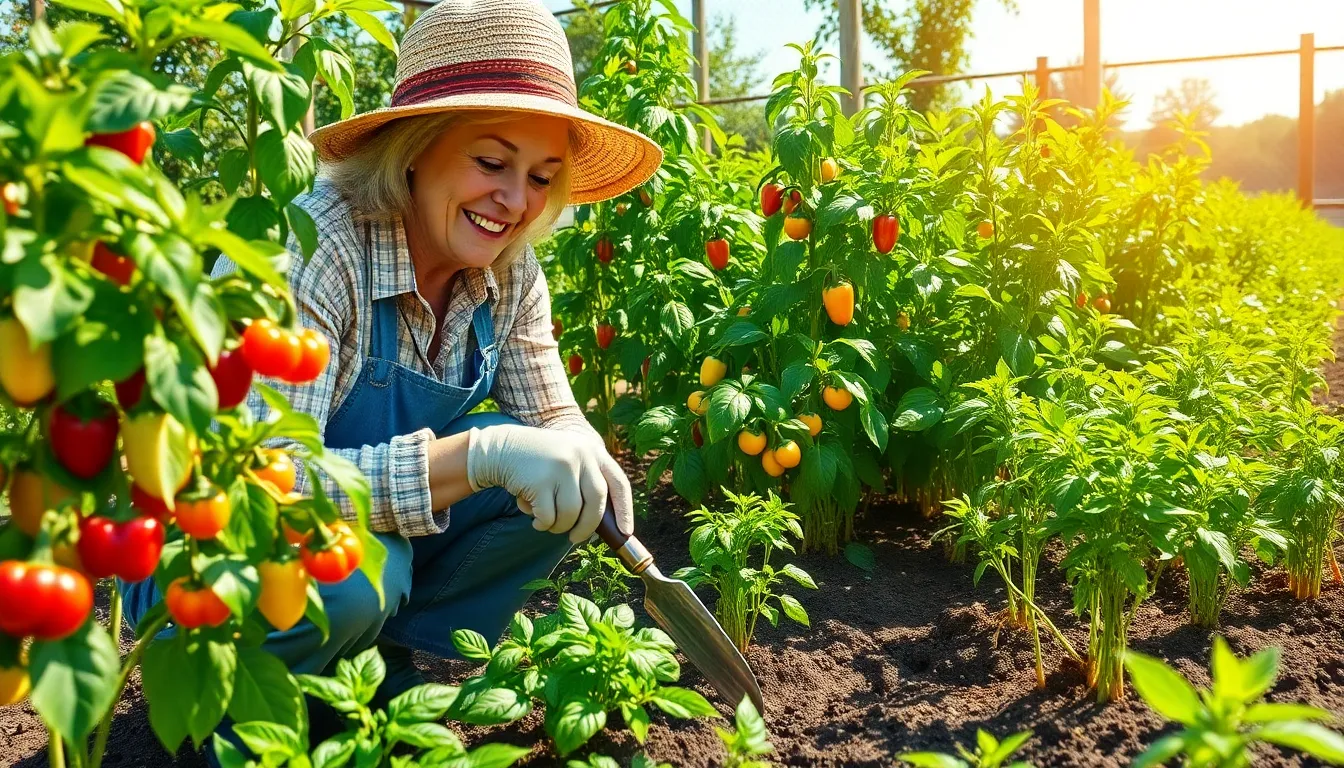
Strategic timing transforms our companion planting efforts from good to exceptional. We’ll maximize pepper garden success by aligning our planting schedule with each season’s unique opportunities.
Spring Preparation Strategies
Establish foundational companions early to create the ideal growing environment before pepper transplants arrive. We recommend starting basil, carrots, onions, and cilantro 2-3 weeks before our last frost date to ensure they’re established when peppers need their protective benefits most.
Select companions that share similar growing requirements with peppers to streamline our garden care routine. Choosing plants that thrive in warm, well-draining soil and full sun conditions eliminates compatibility issues and reduces maintenance complexity.
Prepare soil structure using natural aerators like radishes and carrots that break up compacted earth. These root vegetables create channels for better water infiltration and nutrient distribution, giving our pepper plants the deep root access they need for strong growth.
Plant nitrogen-fixing legumes early to begin soil enrichment processes before peppers require peak nutrition. Bush beans and peas establish their beneficial root bacteria systems during cooler spring weather, ready to provide nitrogen boost when peppers enter their rapid growth phase.
Summer Maintenance Practices
Maintain consistent moisture levels using companion plants like basil as living mulch around pepper bases. Dense foliage from established herbs traps heat and moisture that peppers thrive in while reducing water evaporation by up to 40%.
Harvest companion herbs regularly to encourage continued growth and maintain their pest-repelling properties at peak effectiveness. Frequent pruning of basil, oregano, and thyme keeps these plants producing the aromatic compounds that deter aphids, spider mites, and thrips.
Monitor trap crops closely for pest accumulation and remove affected areas before insects migrate to pepper plants. Nasturtiums and other sacrifice plants require weekly inspection during peak pest season to maintain their protective effectiveness.
Provide additional support structures for both peppers and climbing companions as summer heat accelerates growth rates. Staking or caging prevents wind damage and ensures adequate air circulation between companion plantings.
Fall Succession Planning
Plant cool-season companions like leafy greens and bush beans around established pepper plants in late summer to extend harvest periods. These late additions provide ground cover and soil protection as temperatures begin dropping.
Remove spent companion plants that no longer provide benefits or may harbor overwintering pests before they become problematic. Clearing diseased or exhausted companions prevents pathogen buildup for next season’s plantings.
Convert remaining foliage into green manure by chopping and incorporating healthy plant material directly into soil around pepper plants. This organic matter enriches soil structure and provides slow-release nutrients for continued pepper production.
Plan next season’s companion layout based on current year observations of which combinations performed best in our exact growing conditions. Documentation of successful pairings guides more effective companion selections for improved results.
Conclusion
We’ve explored the groundbreaking power of companion planting for pepper gardens and the remarkable benefits it brings to our growing success. By implementing these strategic partnerships we can create thriving ecosystems that naturally boost yields while reducing our reliance on chemical interventions.
The journey from selecting the right companions to timing our seasonal plantings requires attention to detail but the rewards are substantial. Our pepper plants will flourish in these supportive environments surrounded by beneficial allies that enhance growth and protect against common threats.
Remember that successful companion planting is an ongoing learning process. As we experiment with different combinations and document our results we’ll develop a deeper understanding of what works best in our unique growing conditions. Start small with proven companions like basil and marigolds then expand your garden’s potential as you gain confidence and experience.
Frequently Asked Questions
What is companion planting for peppers?
Companion planting for peppers involves growing specific plants alongside pepper plants to create a supportive environment. This practice enhances growth, protects against pests, and can increase yields by up to 30%. The key is selecting plants that complement peppers rather than compete with them for nutrients, water, or space.
Which herbs make the best companions for peppers?
Basil, oregano, and parsley are excellent herb companions for peppers. Basil repels aphids and spider mites while enhancing pepper flavor. Oregano masks pepper scent from pests and attracts pollinators. Parsley provides nutrient-rich ground cover and creates habitat for beneficial insects that support natural pest control.
Can I grow tomatoes and peppers together?
Yes, tomatoes make excellent companions for peppers since they share similar growing requirements – warm, sunny environments and consistent watering schedules. This pairing works especially well in greenhouse settings where care routines can be streamlined. Both plants thrive under the same conditions without competing significantly.
What flowering plants protect pepper gardens?
Marigolds are the most effective flowering companions, deterring nematodes and aphids with their powerful pest-repelling properties. Nasturtiums act as trap crops, drawing harmful pests away from peppers. Petunias specifically deter hornworms, creating an unfavorable environment for these destructive pests while adding garden beauty.
How do legumes benefit pepper plants?
Legumes like bush beans, peas, and clover improve soil health through nitrogen fixation, naturally enriching the soil with nutrients peppers need. Bush beans provide ground cover without competing for resources, peas act as early-season living mulch, and clover continuously fixes nitrogen while preventing weed establishment.
Which plants should I avoid near peppers?
Avoid planting fennel, brassicas (broccoli, cabbage), and walnut trees near peppers. Fennel has allelopathic properties that inhibit pepper growth and attracts pests. Brassicas compete heavily for nutrients and increase pest pressure. Walnut trees produce toxic compounds and compete for resources, creating hostile growing conditions.
When should I plant pepper companions?
Plant foundational companions like basil, carrots, onions, and cilantro in spring before transplanting peppers. During summer, maintain companion plants as living mulch and monitor trap crops. In fall, add cool-season companions around established peppers to extend harvest periods while removing spent plants to prevent overwintering pests.
How do ground cover companions help peppers?
Ground cover plants like lettuce, spinach, and radishes create a living mulch system that protects soil around pepper plants. They maximize garden space, reduce moisture loss, prevent weed establishment, and improve soil aeration. These low-growing companions work as an understory without competing significantly with pepper plants above ground.

